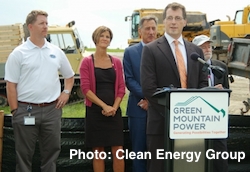A new solar + storage microgrid project has been announced for Rutland, Vermont. The Stafford Hills project is being developed by Green Mountain Power in collaboration with Dynapower and GroSolar. The U.S. Department of Energy, Office of Electricity along with the Energy Storage Technology Advancement Partnership (ESTAP) funded the energy storage component project along with funds from the State of Vermont. In addition, the project is being managed by Clean Energy States Alliance and Sandia National Laboratories.
 “This project is a national model for the future of clean energy – combining solar with energy storage,” said Lewis Milford, president of Clean Energy Group, which manages the Clean Energy States Alliance. “Solar power and battery storage will provide clean reliable power to a school that serves as an emergency shelter, helping a community cope with loss of power in a future disaster. This new form of resilient power is what all communities need to protect themselves from power outages in severe weather events.”
“This project is a national model for the future of clean energy – combining solar with energy storage,” said Lewis Milford, president of Clean Energy Group, which manages the Clean Energy States Alliance. “Solar power and battery storage will provide clean reliable power to a school that serves as an emergency shelter, helping a community cope with loss of power in a future disaster. This new form of resilient power is what all communities need to protect themselves from power outages in severe weather events.”
According to Clean Energy Group, this project is unique in several ways:
- It is one of the first exclusively solar-powered microgrids in the US, and the first to provide full back-up to an emergency shelter on the distribution network;
- It is the first solar+storage microgrid to be developed on a brownfield site, contributing to brownfield redevelopment efforts in Rutland, VT;
- It incorporates 7,722 solar panels, capable of generating 2.5 MW of electricity, helping GMP to reach its goal of making Rutland, VT the Solar Capital of New England, and helping Vermont to reach its renewable energy goals;
- It incorporates 4 MW of battery storage, both lithium ion and lead acid, to integrate the solar generation into the local grid, and to provide resilient power in case of a grid outage;
- It incorporates innovative multi-port inverters designed specifically for this project by Dynapower, a local Vermont firm;
- It will provide resilient power to a Rutland school that serves as a public emergency shelter (additional critical facilities may be similarly supported by this microgrid in the future); and
- It will provide clean, distributed generation and resilient power to an economically challenged, urban community that is targeted for revitalization, and that suffers frequent power outages due to storms.
Dr. Imre Gyuk, Energy Storage Program Manager in the Office of Electricity Delivery and Energy Reliability, U.S. Department of Energy, added, “This project provides resilient power during emergencies while benefitting the grid at other times. The technical innovations will reduce cost and make the project commercially viable. This is the perfect project! It has social value, technical innovation, and furthers renewable integration for the grid.”

